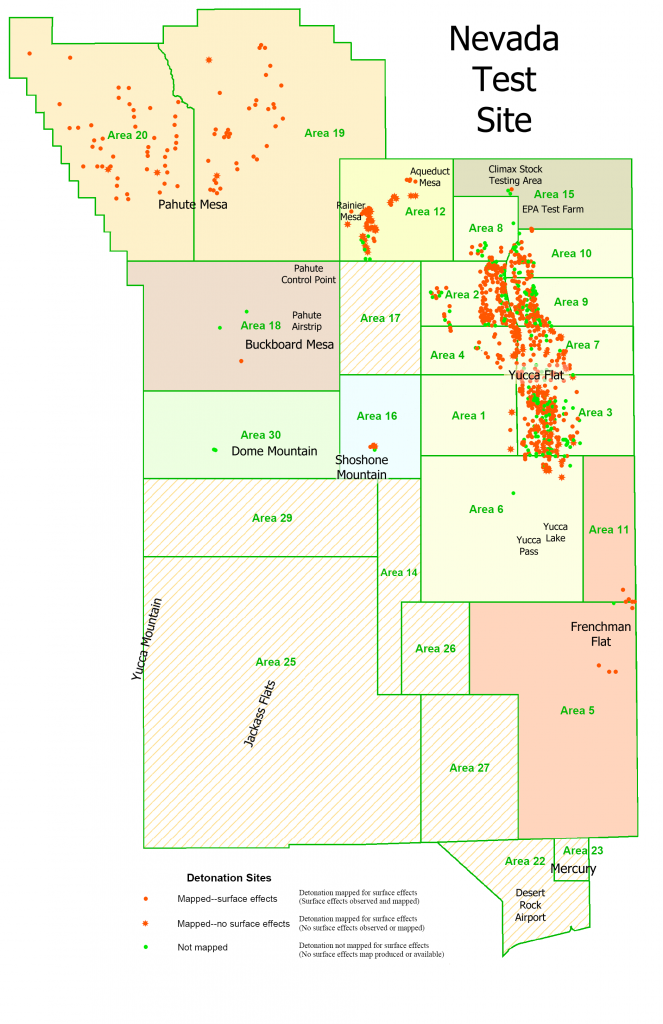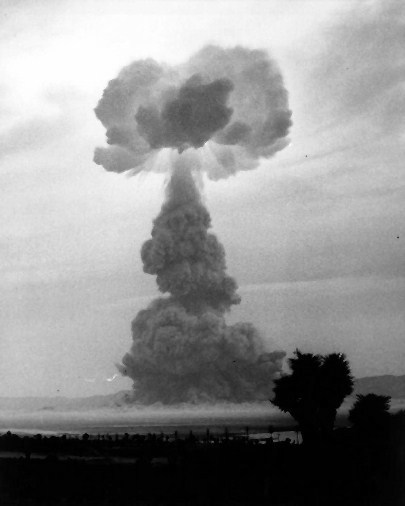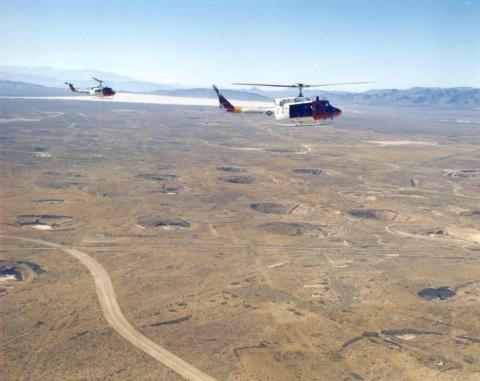The Nevada Test Site Downwinders are individuals living in Arizona, Nevada, and Utah who were exposed to radiation from atmospheric nuclear tests. These tests largely took place from January of 1951 until 1957, when scientists at the site urged the government to halt atmospheric tests due to the effects of radiation on the public. Although this decision was proactive — all atmospheric testing was banned in 1963 — the years of testing created long-lasting health and environmental concerns. For residents of cities such as St. George, Utah, marked increases in various types of cancer occurred nearly three decades after testing ceased. As the Downwinders attempted to remedy their illnesses, they faced opposition from the federal government, which sought to downplay the role nuclear testing had on civilians. Their struggle for recognition, and the healthcare they desire, is ongoing.
Populations Surrounding the Nevada Test Site and Warning Signs
As the Cold War began to heat up, the United States wanted a testing site for observing nuclear weapon usage, effect, and strategic implementation. They selected a site about 100 miles southeast of the Nye County seat of Tonopah, and approximately 65 miles northwest of the greater Las Vegas area. The Nevada Test Site proved to be valuable in scientific research and development. Tests conducted there enabled scientists to better understand blast yields, damage radii, and effectiveness of different weapon designs. The site was home to 928 atmospheric and underground nuclear tests, 100 of which were atmospheric, and thus more likely to spread radiation to nearby areas. Simply defined, atmospheric nuclear tests are those which occur above the surface of the Earth but below the exosphere; underground tests are performed at varying depths underground.
The Nevada site’s location appeared to be nearly perfect; it was located in an extremely rural, flat area that offered security and secrecy. It was built on a previously established military site, the Nellis Air Force Gunnery and Bombing Range, which meant that civilians did not have to be relocated. The area was not heavily populated by animals, nor was there a major river nearby, which mitigated environmental impacts.
However, the extremely rural nature of the site made it difficult to locate all families that might be living nearby. Without the knowledge that they were there, the government failed to adequately warn people who may have been affected by radioactive fallout from the nuclear tests. In an August 1, 1950 meeting at Los Alamos, Enrico Fermi and Edward Teller discussed the Nevada Test Site location. Both concluded there was risk in the site’s location. However, if a maximum yield quantity was observed and if test dates were chosen by meteorologists to limit radioactive fallout dispersion, it was determined the Nevada Proving Grounds would work. Neither of these recommendations were strictly adhered to in subsequent years. Furthermore, many of the communities in the surrounding ranch towns were subsistence farmers, and consumed locally produced milk, beef, and vegetables, all of which were exposed to fallout from the tests. The combination of these factors made the Nevada Downwinders especially vulnerable to radiation exposure.

Testing and Exposure
Atmospheric tests represented most of the early testing in Nevada. These tests were conducted using atomic bombs dropped from planes, balloons, and towers. They varied in strength and detonation altitude, with the bombs that exploded closest to the ground causing the most fallout. While most of the bombs tested at Nevada were not as strong as their counterparts used in the Pacific Island Proving Grounds, they still produced large amounts of radioactive fallout. It is estimated that nearly 150 million curies of radioactive material was released through the atmospheric tests conducted from 1951 to 1962. This amount of radiation equates to about twenty times the amount of radiation released during the Chernobyl nuclear accident.
People were exposed to radiation from a variety of ways. Many on-site operators had no choice — it was their job to observe and record various details about the explosion and eventual aftermath. Soldiers were often required to watch the blasts for training purposes and at times were ordered to enter contaminated areas in order to clean radioactive test objects. Many of these soldiers became known as “atomic veterans.” Some of the civilian population exposed themselves by going to designated areas to watch the blasts. Many brought their breakfasts for the early morning blasts and conversed with their neighbors excitedly. Other civilians were more cautious, staying indoors for hours at a time following the blasts.
As public understanding of radiation exposure improved, people increasingly tried staying indoors and far away during the tests. But even these precautions could do little to prevent exposure. Fallout landed on grasses and vegetables. Vegetables were consumed directly, while cows and goats ate the grass. These animals produced milk which many families consumed locally, and large amounts of radionuclides were ingested by individuals, especially children, this way.
“Dirty Harry”
The Harry Shot took place on May 19, 1953 as part of Operation Upshot-Knothole. The bomb was designed by Ted Taylor at Los Alamos and was transferred to the Nevada site for testing soon after. The goal of Harry was to test the new hollow-core design, which was expected to be the most efficient bomb design up to that point. By “efficient,” scientists meant that very little fissionable material would be needed to create a relatively large explosion. Indeed, Harry surprised scientists, yielding thirty-two kilotons. This was a full twenty kilotons above the advisable yield level to limit radiation exposure, as determined by the Atomic Energy Commission’s Chief Medical Officer.
The fallout produced by Harry was carried by strong early morning winds northeast toward St. George, Utah and other surrounding communities. The larger than expected amount of fallout, and the subsequent health risks believed to be associated with it, earned the test the nickname “Dirty Harry.”
 The nickname had truth behind it. Operation Upshot-Knothole created 50% of all of the radiation the public within a 300-mile radius was exposed to during the entirety of testing at the Nevada Site. 75% of Upshot-Knothole’s radiation came from the Harry Shot. Geiger counters in the center of St. George reportedly experienced radiation spikes of 300-350 milliroentgens, fully maxing out some of the counters that were used. However, very few citizens were told to shelter. Witnesses claim that children were still playing at morning recess, a full hour after the radiation had settled. It would take several more hours for the message to be relayed that individuals should take cover.
The nickname had truth behind it. Operation Upshot-Knothole created 50% of all of the radiation the public within a 300-mile radius was exposed to during the entirety of testing at the Nevada Site. 75% of Upshot-Knothole’s radiation came from the Harry Shot. Geiger counters in the center of St. George reportedly experienced radiation spikes of 300-350 milliroentgens, fully maxing out some of the counters that were used. However, very few citizens were told to shelter. Witnesses claim that children were still playing at morning recess, a full hour after the radiation had settled. It would take several more hours for the message to be relayed that individuals should take cover.
In the following days, the public became extremely concerned with the Harry Shot. Concern became so widespread that the AEC had to issue an emergency film to convince the public that they were safe. The AEC did not, however, offer corrective or preventive measures — such as not consuming local vegetables and milk for a period of time, or staying indoors immediately following a detonation — for future tests. Instead, the entire situation was smoothed over so that a panic did not ensue, and the population remained in the dark about possible health consequences.
John Wayne and The Conqueror
Probably the most famous Downwinder case to arise from the Nevada Site involved the 1956 production of The Conqueror. Directed by Dick Powell, the epic movie focused on a war between Genghis Khan and Tartar leaders over Bortai, the beautiful daughter of a Tartar chieftain. The film included blockbuster names such as John Wayne, Agnes Moorehead, Susan Hayward, and Pedro Armendáriz.
Overshadowing the movie’s stars and plot, however, was the revelation that many of those involved in The Conqueror’s production developed cancer in subsequent years. The outdoor scenes of the film were shot just outside St. George, Utah, one of the towns most heavily irradiated during the nuclear testing at the Nevada Test Site. The film crew spent several weeks at the site, a year after “Dirty Harry” had been detonated less than 150 miles away.
91 of the 220 cast and crew had developed cancer by 1980, and of these, 46 had died. Most notably, in 1979, John Wayne passed away from stomach cancer at the age of 72. Fifteen years previously, Wayne had also had a bout with lung cancer, from which he recovered. Wayne was also visited by several family members while working on the set of The Conqueror, several of whom also developed cancer or tumors. These family members included his son and brother, neither of whom died from their afflictions. Word quickly spread that a pattern had formed and that the actors and actresses from The Conqueror were dying from cancer. A scientist from the Pentagon defense nuclear agency even famously declared, upon hearing rumors that Wayne had died due to cancer from radiation exposure, “Please, God, don’t let us have killed John Wayne.”_film_poster-196x300.jpg)
Many of those closest to Wayne argued that his cancer was caused by his cigarette smoking, rather than radiation exposure. While this likely is the reason for Wayne’s cancer — and probably was case for many of the other actors and actresses on set — the movie brought light to concerns that many Nevada Downwinders had expressed for years previously.
Legal Action
Anger mounted throughout Downwinder communities as various government documents came to light and cancer rates continued to soar into the 1970s. Leukemia rates in Downwind Utah Mormon communities exceeded their non-Downwind counterparts by approximately five times. Pockets of thyroid cancer, especially in young children, spiked in areas which had never experienced childhood cancers.
The first steps toward legal action and reparations for the Nevada Site Downwinders came during the late 1970s. Senator Ted Kennedy sponsored a bill, the Radiation Exposure Compensation Act (RECA) of 1979, that would hold the “United States liable for damages to certain individuals, to certain uranium miners, and to certain sheep herds, due to certain nuclear tests at the Nevada Test Site.” After its fifth draft, the bill was introduced in the 96th Congress, but did not receive a vote.
A decade later, the Nevada Site Downwinders finally got a breakthrough with the passage of the Radiation Exposure Compensation Act. Signed into law by President George H.W. Bush on October 15, 1990, the bill would provide tiered compensation for individuals affected by nuclear testing in various capacities, from on-site workers to those living in downwind communities. The lowest level of compensation for a case was established at $50,000 while the upper limit was $100,000. The bill also stipulated a timeframe for residence in the areas covered by the bill (22 counties in Utah and Nevada), and listed the diseases that would qualify a candidate for payment. Diseases covered under the act included leukemia, thyroid cancer, bone cancer, and any other cancer determined by the National Cancer Institute to “develop after exposure to low level radiation.”
The government initially only expected several hundred applicants. This turned out to be a massive underestimate. As of April 20, 2018, 34,372 claims had been approved for a total of $2,243,205,380. Nevada Site Downwinders have fared better than some other Downwinder communities in this respect, some of whom (such as the Tularosa Basin Downwinders) are still seeking compensation and recognition.
However, the time that elapsed between the tests and financial compensation often meant that Downwinders died before they received their benefits. Furthermore, the children and grandchildren of many Nevada Site Downwinders continue to claim that they, too, have major health complications due to the radiation they or their older relatives experienced. These include mental and physical disabilities at birth, as well as preexisting conditions that show symptoms earlier in childhood than normal. Litigation concerning these cases is ongoing.
Controversy
_001-244x300.jpg) While some controversy continues about who exactly qualifies for financial compensation, the main disputes brought forth by the Nevada Site Downwinder community concern government transparency in the days of nuclear testing. Military and government officials were extremely slow to admit that the tests might be exposing citizens to high levels of radiation. Many citizens were actually encouraged to watch the explosions. Soldiers performed military drills directly following detonations. Few steps were taken by those conducting the test to inform the public of possible complications, and thus many people were exposed to fallout that likely could have avoided it.
While some controversy continues about who exactly qualifies for financial compensation, the main disputes brought forth by the Nevada Site Downwinder community concern government transparency in the days of nuclear testing. Military and government officials were extremely slow to admit that the tests might be exposing citizens to high levels of radiation. Many citizens were actually encouraged to watch the explosions. Soldiers performed military drills directly following detonations. Few steps were taken by those conducting the test to inform the public of possible complications, and thus many people were exposed to fallout that likely could have avoided it.
Furthermore, complications persist regarding the actions taken by the military during early testing at the Nevada Site. “War games” often included tactical training exercises that featured frontal charges by troops into fallout zones, often just minutes following detonation. Many soldiers that participated in these exercises would later develop diseases related to radiation exposure. The secretive nature surrounding military procedures and conduct, however, silenced their claims for years afterward and bred distrust of the government within this specific Nevada Downwinder community.
Ongoing Issues
The Nevada Test Site contains some of the most radioactive land areas in the world. This contamination came largely from the underground testing, which did not impact humans as much, but irradiated dirt and rubble around the site as well as underground aquifers. Underground testing began in 1957 and lasted until 1992, when the United States entered a nuclear testing moratorium.
Unlike some other Downwinder communities, the first generation survivors in the Nevada range have received compensation for their illnesses. Second and third generation Downwinders, however, continue their legal struggle to be recognized as an impacted community. To date, none of these individuals have received reparations, even though many of them suffer pre-existing diseases and conditions they believe are associated with their residency near the Nevada Test Site.





